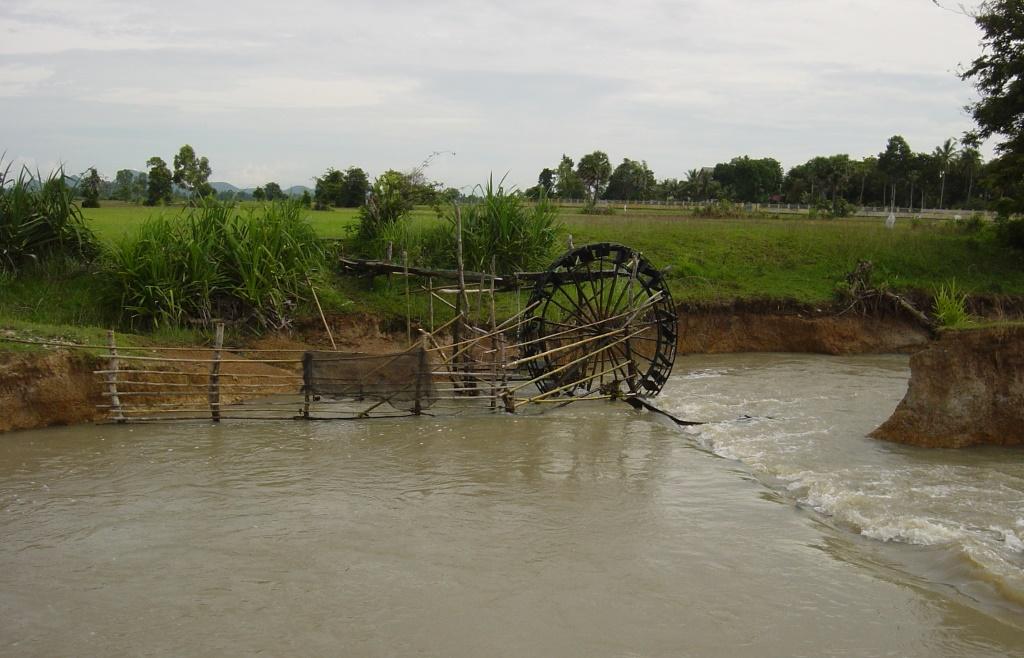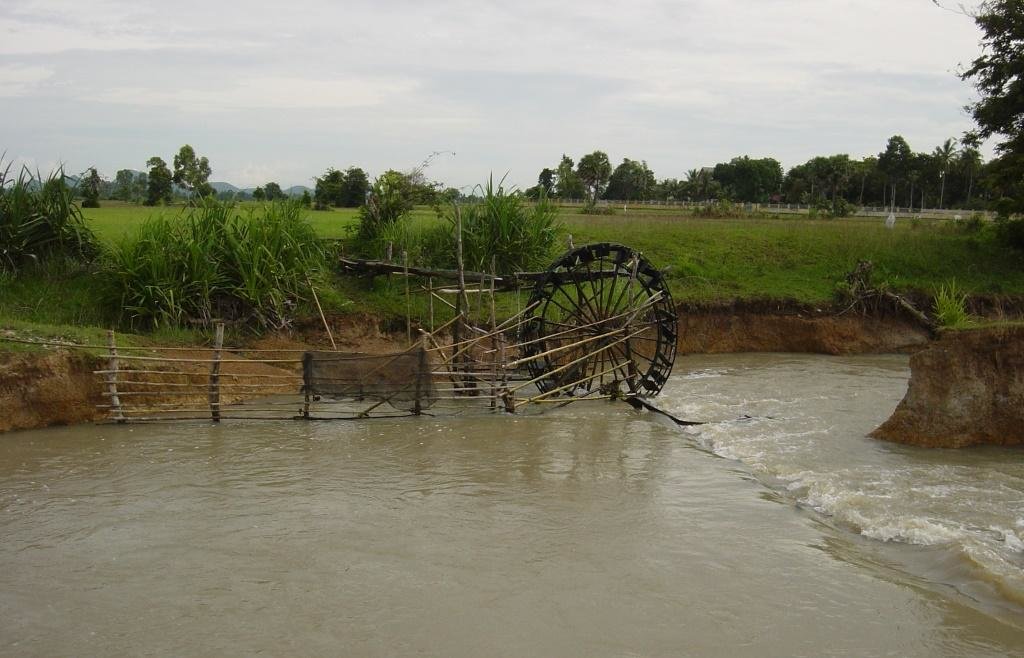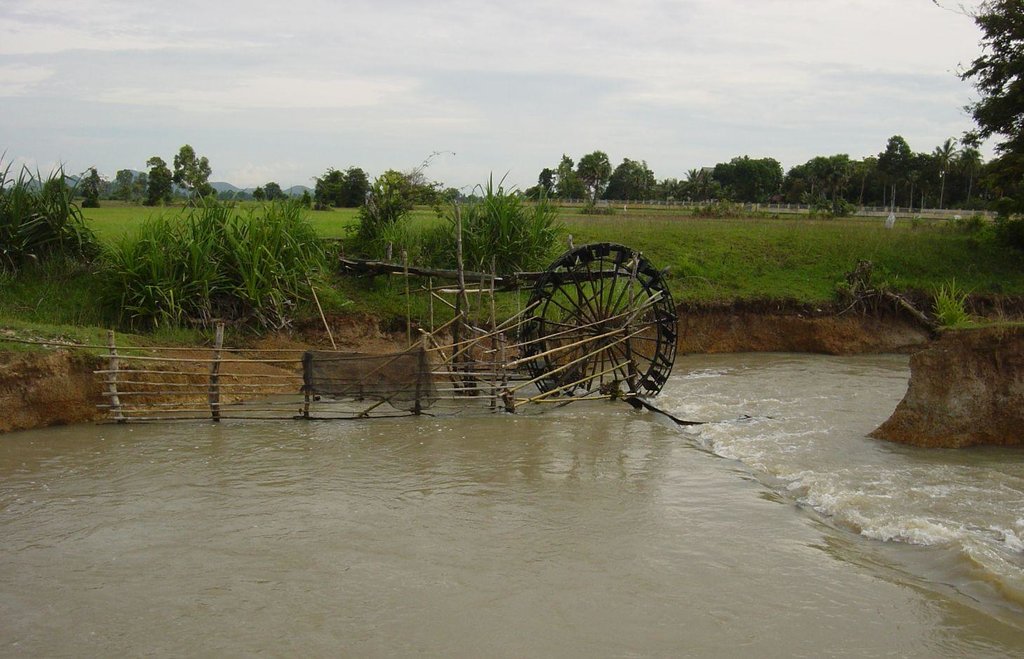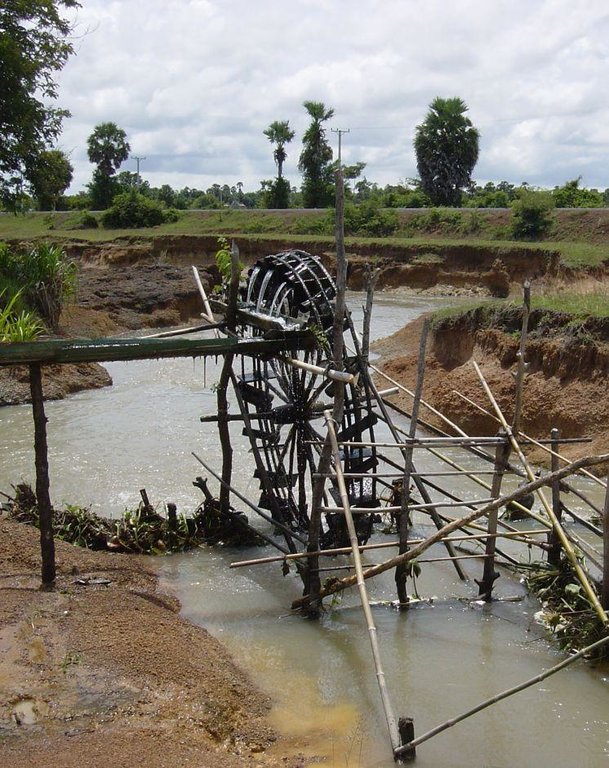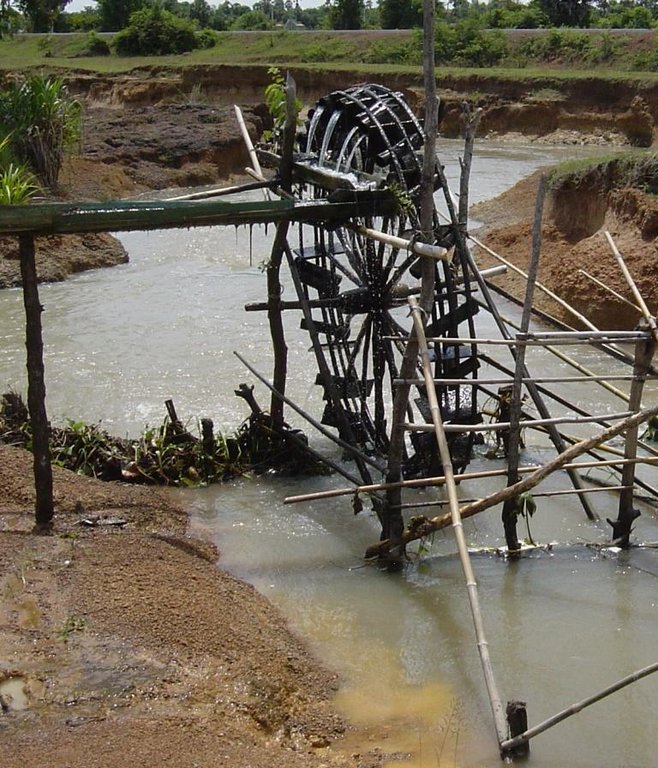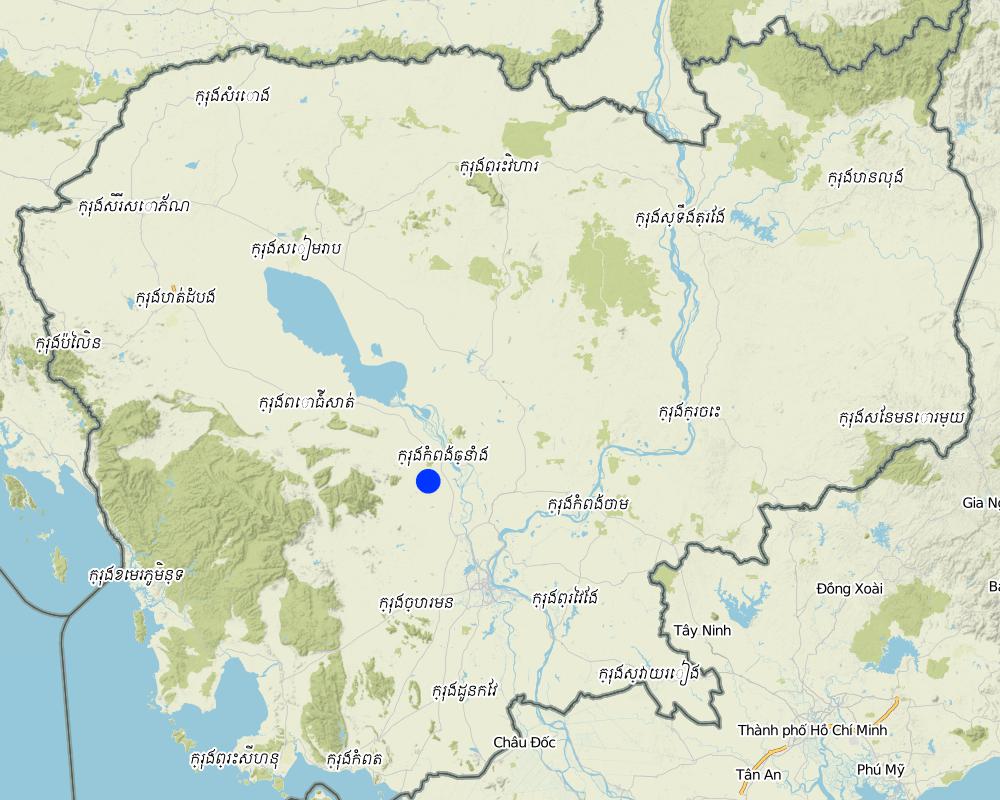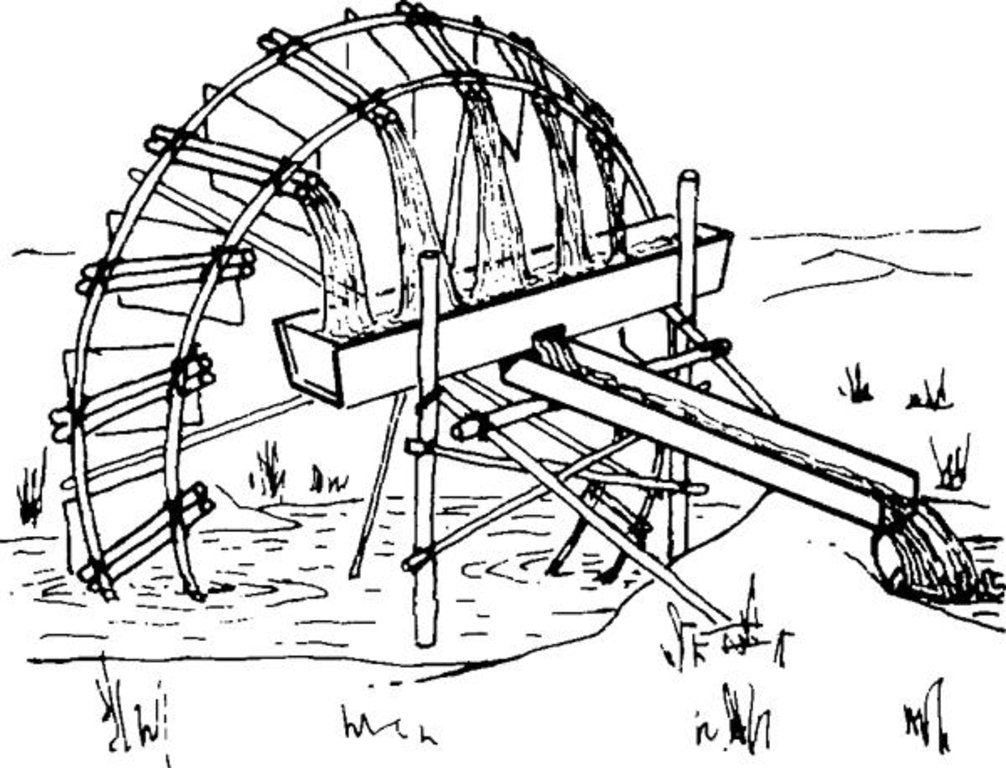Irrigation of paddy fields using water-pumping wheels (Norias) [Cambodia]
- Creation:
- Update:
- Compiler: Christoph Kaufmann
- Editor: –
- Reviewers: Deborah Niggli, Alexandra Gavilano
រហាត់ទឹក (Khmer)
technologies_1644 - Cambodia
View sections
Expand all Collapse all1. General information
1.2 Contact details of resource persons and institutions involved in the assessment and documentation of the Technology
land user:
Khun Lean Hak
SOFDEC/LAREC, www.sofdec.org
Cambodia
SLM specialist:
Sreytouch Bin
SOFDEC
Cambodia
SLM specialist:
Pith Khonhel
LAREC
Cambodia
Name of the institution(s) which facilitated the documentation/ evaluation of the Technology (if relevant)
Society for Community Development in Cambodia (SOFDEC) - CambodiaName of the institution(s) which facilitated the documentation/ evaluation of the Technology (if relevant)
Local Agricultural Research and Extension Centre (LAREC) - Cambodia1.3 Conditions regarding the use of data documented through WOCAT
The compiler and key resource person(s) accept the conditions regarding the use of data documented through WOCAT:
Yes
1.4 Declaration on sustainability of the described Technology
Is the Technology described here problematic with regard to land degradation, so that it cannot be declared a sustainable land management technology?
No
1.5 Reference to Questionnaire(s) on SLM Approaches (documented using WOCAT)
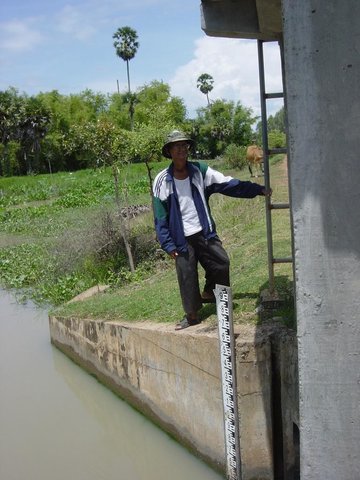
Water user group [Cambodia]
A water user group, led by a committee staff, decides about the distribution of the water during the dry season to plant dry season rice.
- Compiler: Stefan Graf
2. Description of the SLM Technology
2.1 Short description of the Technology
Definition of the Technology:
Norias are water-pumping wheels made of bamboo which are used to irrigate paddy fields in order to increase the yield.
2.2 Detailed description of the Technology
Description:
Norias are undershot waterwheels used to pump up water. They are a traditional technology in south-east Asia, where the technology is passed on from father to son. Norias are traditionally made of bamboo and wood. The stream powers the wheel; the bamboo tubes closed at one end fill with water, carry it up and release it in a trough which flows to the fields. To avoid damages from floating debris and water plants, a diverting bamboo fence is built upstream.
When the water level in the river is lower, an underwater bound is built to direct it toward the wheel and ensure a continuous pumping. This is done around three times a year. In case of a flood, the waterwheel can be damaged or destroyed, which occurs around once a year. The noria described in this case study is in use from June to November, as the river dries out. With its 3 m diameter it allows the production of two rice harvests a year on 2.5 ha. During the dry season, it is removed and repaired.
The purpose of this irrigation device is to ensure a permanent water access in the rice field, and to produce 2 harvests instead of one per year. The norias are low cost devices which are built by the farmer themselves, but can only be used to irrigate fields which are located close to a river.
To build a noria, an experienced farmer only needs around one day, and wood and bamboo worth around 25 US$. It is installed at the beginning of the rainy season, and removed at the end to be fixed. In case of floods (which happens around once a year) it also needs to be fixed. The maintenance costs are around a quarter of the establishment costs. When the water level drops, a berm is built in the water to redirect the water toward the wheel, which is needed around three times a year. With this berm, the speed and thus pumping of water can be regulated.
The analysed area is flat (slope < 2%), with a tropical climate (dry and wet season), and the soils are mostly sandy or loamy. The soils contain little organic matter (low soil fertility, acidification, small amount of cattle, area has been deforested a long time ago) and the groundwater table is rather high (2 m below soil level during the dry season, on the surface during the wet season). There are many temporary and a few permanent streams in the area.
Due to climate change, the rainfalls are more erratic, temperatures rise and droughts are more recurrent. Rice is the predominant crop grown in the area, since it serves as staple food (mix subsistence and commercial activities). Rice is often grown in monocultures and harvested once a year. Once the rice is harvested (dry season), some farmers release cattle to the paddy fields to eat the straw and weeds.
As an addition to rice, most land users grow vegetables and fruits in small home gardens (subsistence) and complement their income by producing handicrafts or through off-farm income / remittances from family members working in other places. The increasing migration rate (the young generation leaves the villages to work in the cities, garment industry or abroad) results in a decrease of available labour force in the area which has detrimental effects on the agricultural activities. Furthermore, the civil war in the 1970s (Khmer Rouge) led to the loss of agricultural knowledge which different NGOs try to re-establish.
2.3 Photos of the Technology
2.5 Country/ region/ locations where the Technology has been applied and which are covered by this assessment
Country:
Cambodia
Region/ State/ Province:
Kampong Chhnang
Further specification of location:
Toeuk Phos
Specify the spread of the Technology:
- evenly spread over an area
If precise area is not known, indicate approximate area covered:
- 0.1-1 km2
Map
×2.6 Date of implementation
If precise year is not known, indicate approximate date:
- more than 50 years ago (traditional)
2.7 Introduction of the Technology
Specify how the Technology was introduced:
- as part of a traditional system (> 50 years)
Comments (type of project, etc.):
Norias are a traditional setting in south-east Asia. The farmer from this case study learned it from his father, and the family continuously used them for generations (except during the Pol Pot regime).
3. Classification of the SLM Technology
3.1 Main purpose(s) of the Technology
- improve production
- create beneficial economic impact
3.2 Current land use type(s) where the Technology is applied

Cropland
- Annual cropping
Annual cropping - Specify crops:
- cereals - rice (wetland)
Number of growing seasons per year:
- 1
Specify:
Longest growing period in days: 210, Longest growing period from month to month: June-December

Waterways, waterbodies, wetlands
Comments:
Major land use problems (compiler’s opinion): Low soil fertility, lack of irrigation, monocultures, overgrazing, soil left bare after ploughing.
Major land use problems (land users’ perception): Lack of irrigation.
Livestock is grazing on crop residues
3.4 Water supply
Water supply for the land on which the Technology is applied:
- mixed rainfed-irrigated
3.5 SLM group to which the Technology belongs
- irrigation management (incl. water supply, drainage)
- water diversion and drainage
3.6 SLM measures comprising the Technology

structural measures
- S11: Others
3.7 Main types of land degradation addressed by the Technology

water degradation
- Ha: aridification
Comments:
Main causes of degradation: soil management, crop management (annual, perennial, tree/shrub) (Rice monocultures, with soil left bare after ploughing.), droughts (More erratic rainfall.)
Secondary causes of degradation: overgrazing (Uncontrolled grazing of cattle.), change in temperature (More hot days.)
3.8 Prevention, reduction, or restoration of land degradation
Specify the goal of the Technology with regard to land degradation:
- reduce land degradation
- restore/ rehabilitate severely degraded land
4. Technical specifications, implementation activities, inputs, and costs
4.1 Technical drawing of the Technology
Technical specifications (related to technical drawing):
Noria, undershot water wheel lifting up water. The stream pushes the wheel, while the bamboos closed on one side are filled with water which is released into the trough where it flows to the fields.
Technical knowledge required for field staff / advisors: high
Technical knowledge required for land users: low (This is the farmers opinion. He said building norias is easy, everybody in the village could build them. On the other hand, only farmers who learned it from their father use it.)
Main technical functions: water harvesting / increase water supply
Secondary technical functions: increase of biomass (quantity)
Structural measure: Noria
Construction material (earth): The bank is built in the river when the water level is low to divert the water toward the wheel.
Construction material (wood): Bamboo fence in the water to avoid damages by floating plants or waste.
Beneficial area: 2.5 ham2
Author:
FAO, Rome, http://www.fao.org/docrep/010/ah810e/AH810E05.htm
4.2 General information regarding the calculation of inputs and costs
Indicate average wage cost of hired labour per day:
5.00
4.3 Establishment activities
| Activity | Timing (season) | |
|---|---|---|
| 1. | Build and install the noria. |
4.4 Costs and inputs needed for establishment
| Specify input | Unit | Quantity | Costs per Unit | Total costs per input | % of costs borne by land users | |
|---|---|---|---|---|---|---|
| Labour | labour | 1.0 | 15.0 | 15.0 | 100.0 | |
| Equipment | tools | 1.0 | 20.0 | 20.0 | 100.0 | |
| Construction material | wood | 1.0 | 25.0 | 25.0 | 100.0 | |
| Total costs for establishment of the Technology | 60.0 | |||||
| Total costs for establishment of the Technology in USD | 60.0 | |||||
4.5 Maintenance/ recurrent activities
| Activity | Timing/ frequency | |
|---|---|---|
| 1. | Repair and reinstall the water wheel | Yearly, at the wet season of the dry season and after the floods. |
| 2. | Build a small bound inside the river to redirect the water toward the noria | When the water level sinks, approximately 3 times/year |
4.6 Costs and inputs needed for maintenance/ recurrent activities (per year)
| Specify input | Unit | Quantity | Costs per Unit | Total costs per input | % of costs borne by land users | |
|---|---|---|---|---|---|---|
| Labour | labour | 1.0 | 20.0 | 20.0 | 100.0 | |
| Construction material | wood | 1.0 | 12.5 | 12.5 | 100.0 | |
| Total costs for maintenance of the Technology | 32.5 | |||||
| Total costs for maintenance of the Technology in USD | 32.5 | |||||
Comments:
Machinery/ tools: hatchet, saw, drill
The costs were calculated in 2014 for a noria of around 3 m diameter, irrigating 2.5 ha of rice fields.
4.7 Most important factors affecting the costs
Describe the most determinate factors affecting the costs:
The availability of wood and bamboo determines the costs.
5. Natural and human environment
5.1 Climate
Annual rainfall
- < 250 mm
- 251-500 mm
- 501-750 mm
- 751-1,000 mm
- 1,001-1,500 mm
- 1,501-2,000 mm
- 2,001-3,000 mm
- 3,001-4,000 mm
- > 4,000 mm
Specifications/ comments on rainfall:
1486.45 mm 2013 in Kampong Chhnang
Agro-climatic zone
- sub-humid
Thermal climate class: tropics. 27-35°C
5.2 Topography
Slopes on average:
- flat (0-2%)
- gentle (3-5%)
- moderate (6-10%)
- rolling (11-15%)
- hilly (16-30%)
- steep (31-60%)
- very steep (>60%)
Landforms:
- plateau/plains
- ridges
- mountain slopes
- hill slopes
- footslopes
- valley floors
Altitudinal zone:
- 0-100 m a.s.l.
- 101-500 m a.s.l.
- 501-1,000 m a.s.l.
- 1,001-1,500 m a.s.l.
- 1,501-2,000 m a.s.l.
- 2,001-2,500 m a.s.l.
- 2,501-3,000 m a.s.l.
- 3,001-4,000 m a.s.l.
- > 4,000 m a.s.l.
5.3 Soils
Soil depth on average:
- very shallow (0-20 cm)
- shallow (21-50 cm)
- moderately deep (51-80 cm)
- deep (81-120 cm)
- very deep (> 120 cm)
Soil texture (topsoil):
- coarse/ light (sandy)
- medium (loamy, silty)
Topsoil organic matter:
- low (<1%)
5.4 Water availability and quality
Ground water table:
on surface
Availability of surface water:
good
Water quality (untreated):
poor drinking water (treatment required)
Comments and further specifications on water quality and quantity:
during dry seasons
5.5 Biodiversity
Species diversity:
- low
5.6 Characteristics of land users applying the Technology
Market orientation of production system:
- mixed (subsistence/ commercial)
Off-farm income:
- 10-50% of all income
Relative level of wealth:
- average
Individuals or groups:
- individual/ household
Gender:
- men
Indicate other relevant characteristics of the land users:
Land users applying the Technology are mainly common / average land users
Difference in the involvement of women and men: Heavy labour, and skills are passed on from father to son.
Population density: 10-50 persons/km2
Annual population growth: 0.5% - 1% (Rich farmers use pumps, poor farmers do not have land near the river.).
Off-farm income specification: Handicraft, remittances, and factory work.
5.7 Average area of land used by land users applying the Technology
- < 0.5 ha
- 0.5-1 ha
- 1-2 ha
- 2-5 ha
- 5-15 ha
- 15-50 ha
- 50-100 ha
- 100-500 ha
- 500-1,000 ha
- 1,000-10,000 ha
- > 10,000 ha
Is this considered small-, medium- or large-scale (referring to local context)?
- medium-scale
5.8 Land ownership, land use rights, and water use rights
Land ownership:
- communal/ village
- individual, not titled
Land use rights:
- communal (organized)
- individual
Water use rights:
- open access (unorganized)
Comments:
Land users have a title that is not recognized by the state.
5.9 Access to services and infrastructure
health:
- poor
- moderate
- good
education:
- poor
- moderate
- good
technical assistance:
- poor
- moderate
- good
employment (e.g. off-farm):
- poor
- moderate
- good
markets:
- poor
- moderate
- good
energy:
- poor
- moderate
- good
roads and transport:
- poor
- moderate
- good
drinking water and sanitation:
- poor
- moderate
- good
financial services:
- poor
- moderate
- good
6. Impacts and concluding statements
6.1 On-site impacts the Technology has shown
Socio-economic impacts
Production
crop production
Comments/ specify:
2 rice harvests instead of one.
risk of production failure
Comments/ specify:
No problems during dry season.
production area
Comments/ specify:
Same land twice under use.
Water availability and quality
demand for irrigation water
Income and costs
expenses on agricultural inputs
Comments/ specify:
Pumps are around 10 times more expensive to rent.
farm income
Socio-cultural impacts
food security/ self-sufficiency
Comments/ specify:
2 harvests, without risk of failure due to drought.
contribution to human well-being
Comments/ specify:
2 rice harvests instead of one improves the livelihood of the farmers applying this technology.
Ecological impacts
Water cycle/ runoff
water quantity
Comments/ specify:
Decreased water availability in the river.
Soil
soil moisture
soil cover
Comments/ specify:
Period of production is increased.
6.3 Exposure and sensitivity of the Technology to gradual climate change and climate-related extremes/ disasters (as perceived by land users)
Gradual climate change
Gradual climate change
| Season | increase or decrease | How does the Technology cope with it? | |
|---|---|---|---|
| annual temperature | increase | well |
Climate-related extremes (disasters)
Meteorological disasters
| How does the Technology cope with it? | |
|---|---|
| local rainstorm | not well |
| local windstorm | well |
Climatological disasters
| How does the Technology cope with it? | |
|---|---|
| drought | well |
Hydrological disasters
| How does the Technology cope with it? | |
|---|---|
| general (river) flood | not well |
Other climate-related consequences
Other climate-related consequences
| How does the Technology cope with it? | |
|---|---|
| reduced growing period | not known |
6.4 Cost-benefit analysis
How do the benefits compare with the establishment costs (from land users’ perspective)?
Short-term returns:
very positive
Long-term returns:
very positive
How do the benefits compare with the maintenance/ recurrent costs (from land users' perspective)?
Short-term returns:
very positive
Long-term returns:
very positive
6.5 Adoption of the Technology
Of all those who have adopted the Technology, how many did so spontaneously, i.e. without receiving any material incentives/ payments?
- 91-100%
Comments:
100% of land user families have adopted the Technology without any external material support
5 land user families have adopted the Technology without any external material support
There is no trend towards spontaneous adoption of the Technology
The suitable water streams are given, norias can only irrigate areas close to streams.
6.7 Strengths/ advantages/ opportunities of the Technology
| Strengths/ advantages/ opportunities in the land user’s view |
|---|
| The river water quality (nutrients) is higher than the quality of rainwater for the irrigation of crops. |
| Through the use of Norias there is always water in the paddy fields; the rice is less threatened by droughts |
| There are two rice harvests each year instead of one. |
| Norias are much cheaper (around 10 times) than renting a water pump. |
| Strengths/ advantages/ opportunities in the compiler’s or other key resource person’s view |
|---|
| Fields are only irrigated when sufficient water is available, thus not depleting the river of all its water, as norias need a rather high water flow rate. |
| Do not rely on fossil fuels. |
6.8 Weaknesses/ disadvantages/ risks of the Technology and ways of overcoming them
| Weaknesses/ disadvantages/ risks in the land user’s view | How can they be overcome? |
|---|---|
| Norias are damaged/destroyed in case of floods. | A weather forecast system would allow to remove/secure the noria in case of a flood. |
| The fields need to be close to a stream, at a distance of max. 100 m as a noria does not pump much water. | Use SRI (System of Rice Intensification) with alternately flooding and drying the fields. |
7. References and links
7.1 Methods/ sources of information
- field visits, field surveys
- interviews with land users
When were the data compiled (in the field)?
14/08/2014
7.2 References to available publications
Title, author, year, ISBN:
FAO report on water pumping devices.
Available from where? Costs?
http://www.fao.org/docrep/010/ah810e/ah810e12.htm
Links and modules
Expand all Collapse allLinks

Water user group [Cambodia]
A water user group, led by a committee staff, decides about the distribution of the water during the dry season to plant dry season rice.
- Compiler: Stefan Graf
Modules
No modules


